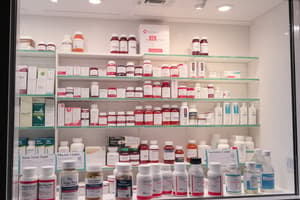Podcast
Questions and Answers
What is the significance of the therapeutic window in pharmacology?
What is the significance of the therapeutic window in pharmacology?
- It focuses solely on maximizing toxic effects for treatment efficacy.
- It highlights the importance of drug resistance in patients.
- It determines the metabolic rate of the drug in the body.
- It indicates the range between effective doses and doses leading to toxicity. (correct)
Which of the following statements regarding a narrow therapeutic window is true?
Which of the following statements regarding a narrow therapeutic window is true?
- It can result in higher incidence of adverse drug reactions with small dose changes. (correct)
- It is associated with drugs that have a predictable response in all patients.
- It presents a greater safety margin between effective and toxic doses.
- It indicates that no dosage adjustments are necessary for the patient.
Which concept serves as the foundation for understanding dosages and drug safety?
Which concept serves as the foundation for understanding dosages and drug safety?
- That only chronic medications need careful dosing considerations.
- That a drug must always be taken at a high dose to be effective.
- That the patient’s age has no impact on drug metabolism.
- That all drugs have potential toxic effects, emphasizing the need for correct dosing. (correct)
What defines medicines with closed therapeutic windows, such as certain chemotherapeutics?
What defines medicines with closed therapeutic windows, such as certain chemotherapeutics?
When assessing the safe use of medications, what is critical to prevent adverse health impacts?
When assessing the safe use of medications, what is critical to prevent adverse health impacts?
Flashcards are hidden until you start studying
Study Notes
Therapeutic Window Concept
- Originates from the idea that "all drugs are poisons," credited to Paracelsus in the 1500s; emphasizes the importance of dosage and benefit.
- A drug is defined as any substance that interacts with molecules or proteins serving regulatory functions in living systems.
- In medical pharmacology, focus is on medications intended for therapeutic benefits.
Agonist Dose-Response Curve
- The x-axis represents the dose of medication; the y-axis indicates therapeutic effects.
- Without medication, there's no therapeutic effect; as dosage increases, therapeutic effects correspondingly rise until a maximum effect is achieved.
- Unwanted toxic effects follow a similar curve: initially no toxicity without medication, but toxicity increases with dosage leading to maximum toxic effect.
Ideal Therapeutic Window
- Ideal scenario allows achieving maximum therapeutic effect with no toxic effects at a specific dosage.
- The therapeutic window exists between doses that yield no effect and doses that lead to toxicity.
Characteristics of Therapeutic Windows
- A safe medication has a wide therapeutic window, allowing a significant margin between effective and toxic doses.
- A narrow therapeutic window poses a greater risk, where small increases in dosage may lead to toxicity.
- Medications with narrow windows are more challenging to dose for optimal therapeutic effects without encountering toxicity.
- Some drugs, particularly cancer chemotherapeutics, have closed therapeutic windows; any therapeutic effect achieved is associated with toxicity.
Safety in Dosing
- Safe medications enable maximum therapeutic effect without toxicity, while dangerous medications risk toxicity at effective doses.
- Both therapeutic and toxic doses should be understood to prevent adverse health impacts.
Therapeutic Window Concept
- Concept rooted in Paracelsus's assertion that "all drugs are poisons," highlighting dosage importance.
- Definition of drug: any substance interacting with regulatory molecules or proteins in living systems.
- Medical pharmacology prioritizes medications aimed at providing therapeutic benefits.
Agonist Dose-Response Curve
- X-axis represents medication dose; Y-axis indicates resultant therapeutic effects.
- Absence of medication results in no therapeutic effect, with effects rising as dosage increases until reaching a plateau.
- Toxic effects mirror the dose-response curve: no toxicity without medication, escalating toxicity with higher doses leading to maximum toxic effects.
Ideal Therapeutic Window
- Optimal scenario allows maximum therapeutic effect to be achieved without any toxic effects at a specific dosage.
- Therapeutic window is the range between doses that yield therapeutic effects and those that lead to toxicity.
Characteristics of Therapeutic Windows
- Wide therapeutic window signifies safer medications, offering a greater margin for effective versus toxic doses.
- Narrow therapeutic windows present higher risks; small dosage changes may trigger toxic effects.
- Dosing for narrow therapeutic window medications is more complex, necessitating precise management to optimize therapeutic outcomes without toxicity.
- Certain drugs, especially cancer chemotherapeutics, often have closed therapeutic windows where therapeutic benefits are accompanied by significant toxicity.
Safety in Dosing
- Safe medications provide maximum therapeutic effect with minimized risk of toxicity, while dangerous medications increase toxicity risk even at therapeutically effective doses.
- Understanding both therapeutic and toxic dose levels is critical to avoid adverse health outcomes.
Studying That Suits You
Use AI to generate personalized quizzes and flashcards to suit your learning preferences.




